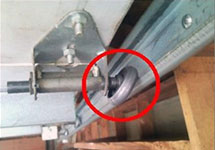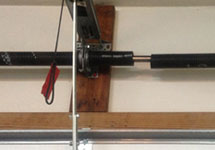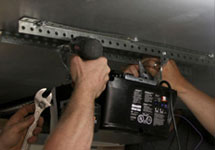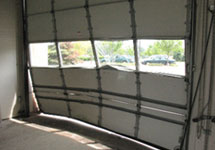If you are having trouble with your garage door, The Door Company (TDC), California’s leading garage door company, may be able to help you troubleshoot the problem. Knowing what’s wrong with your garage door may help you to determine if it is a problem you can tackle or if it’s time to call someone for assistance.

TDC offers the following top 10 reasons your garage door won’t work:
- THE TRANSMITTER BATTERIES ARE DEAD — This may sound obvious, but your garage door transmitters need power to work. If the batteries in your transmitter are dead, the transmitter won’t be able to send a signal to your garage door to open. Check to see if the transmitter on the wall inside your garage still opens your garage door when pressed. If it does, then the transmitter in your car likely just needs a simple battery replacement.
- PHOTO EYE IS OUT OF ALIGNMENT — If you notice that the garage door opens normally but doesn’t make any attempt to close when the remote is pressed, the first thing you’ll want to do is visually inspect the photo eyes. Over time, these eyes can get dirty, causing the light from the beam to be blocked. They also can eventually become misaligned, causing the eyes to not match up on both sides.
- THE TRACK IS NOT ALIGNED — If the garage door track is misaligned you will hear a rubbing noise when the garage door reaches a certain spot on the tracks each time it opens and closes. To realign the track, first loosen the screws that hold the track to the frame. Then, gently tap the track with a rubber mallet to move it back into the proper position. Once you have the alignment correct, tighten the screws securely to ensure the track won’t move and cause more issues when opening your garage door. You’ll need to repeat this same process on the other tracks as well, as these may also be out of alignment.
If the door won’t move at all because of an alignment issue, then this problem isn’t one that you should try to tackle yourself. The garage door professionals at TDC will have the necessary equipment needed to safely realign and repair your garage door. - SOMETHING IS WRONG WITH THE TRANSMITTERS — When you’re in range and the door still won’t open, check to make sure the antenna is hanging down from the motor inside your garage and with no obstructions. Your antenna must be free to clearly receive the signal to open and close the door. Also inspect the antenna for any signs of damage. If it looks like there has been damage to the antenna, you’ll need to call your garage door technician to come out and replace it.
- SOMETHING IS IN THE DOOR’S PATH — Garage doors are designed with a reversing mechanism that prevents them from crushing objects in their path. If you find that your garage door closes part way and then goes back up, this can be triggered by objects on the ground blocking their path such as garbage cans or toys. Inspect the area around your garage door to see if something is blocking the photo eye sensors and look at the tracks to see if there is any buildup on the inside.
- THE SPRINGS ARE BROKEN — If you happen to be home when the springs break, you’ll hear a loud bang from inside your garage. Garage doors can be very heavy and it’s the heavy-duty springs that lift the door. Doors come with one or two torsion springs. If either spring is broken, the garage door opener may struggle to lift the weight of the door or fail to open the door at all. If a spring is broken, call a professional for service as these can be very dangerous to work with. Don’t try to open the door until a professional comes to inspect it and replace the springs. Springs can only be used for a certain number of open and close cycles, and over time they will eventually break and need replacing.
- THE GARAGE DOOR LIMIT SETTINGS ARE OFF — This limit range tells the garage door opener how far the door should move before it’s fully closed. If your settings are too high, the door will hit the ground before the opener thinks it should and assume the door is hitting something in its path, then it will automatically reverse to prevent crushing whatever is beneath it. If you find that adjusting the limit settings isn’t working, it might be time to call TDC to come and help get your garage door to stay closed.
- THE DISCONNECT SWITCH WAS ENABLED — This switch is usually attached to a rope that can be pulled or a knob that can be turned to disconnect. Sometimes, this switch can accidentally come unhooked causing the door to be disconnected from the motor. If your garage door doesn’t open, but the opener motor runs for just a few seconds and then shuts off, the garage door itself may have manually been locked.
- THE DOOR WAS MANUALLY LOCKED — Quite a few garage doors come with manual locks that look like a knob or handle in the middle of your door with two bars running horizontally from each side. There may be a small button on the top or side of the handle that you can press to slide the bars across the doors, thus locking the garage door from the inside. To manually unlock your garage door, simply turn the handle until you hear a clicking sound. This will move the horizontal bars away from the edges and secure the handle in the open position.
- THE TENSION SPRINGS OR CABLES ARE BROKEN — Once the springs break, quite a bit of tension is put on the door cables, and they will often break next. When these cables break, they will snap and forcibly fly out like a broken rubber band. Refrain from parking your car in the garage until the garage door is professionally repaired and do not try to open and close the door while it’s in this condition.
“In conclusion, there are times you might be able to fix a small problem yourself,” said TDC President Mark Stuenkel, “however; there are many situations when it may be best to leave the garage door repair up to the professionals. My team of technicians at The Door Company is happy to help.”



